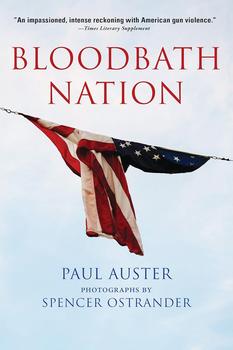Summary | Excerpt | Reviews | Beyond the Book | Read-Alikes | Genres & Themes | Author Bio

This article relates to Bloodbath Nation
.png) Thanks to the numerous photographs that accompany Paul Auster's prose, Bloodbath Nation reads like an extended photo essay, the combination of words and pictures creating a truly indelible work. The images were recorded by New York City–based photographer Spencer Ostrander, for whom this work is deeply personal.
Thanks to the numerous photographs that accompany Paul Auster's prose, Bloodbath Nation reads like an extended photo essay, the combination of words and pictures creating a truly indelible work. The images were recorded by New York City–based photographer Spencer Ostrander, for whom this work is deeply personal.
Ostrander, who was born in Seattle, Washington in 1984, experienced a series of personal tragedies the year he turned 21, when several important people in his life died in close succession. Although he had been studying psychology up until that point, the realization that he lacked permanent images of those loved ones led him to explore photography, first as a hobby and then as a profession.
After transferring from a university in San Francisco to Parsons School of Design in New York City, Ostrander began assisting a variety of photographers working on documentary, portrait and fashion photography. Since then, he has published a great deal of work in magazines, including Playboy, Teen Vogue and Zeit Magazine. But he is best known for an artistic series of photographs titled "Times Square in the Rain." These pictures, collected in a recent book, had their genesis when Ostrander was caught in a sudden rainstorm. He was struck by the ways in which people, having wrapped themselves in plastic ponchos to stay dry, reflected the bright lights of Times Square, turning both the advertisements and themselves into colorful abstractions. To see photos from this collection and others, you can visit his Instagram account.
Ostrander's first collaboration with Paul Auster, Long Live King Kobe, became a sort of accidental companion to Bloodbath Nation. Early in the Bloodbath Nation project, Ostrander showed up at the funeral of Tyler Kobe Nichols, believing the young man had been a victim of gun violence. Ostrander soon learned that Nichols had, in fact, been stabbed—but that didn't lessen the impact of the 21-year-old's death on his family and community. With the cooperation of Nichols's family, Ostrander and Auster embarked on a series of interviews, accompanied by photographic portraits, that combine to depict a community in the midst of trauma and recovery.
Ostrander's history of photographing people in artistic, innovative, emotional ways makes his decision to omit humans from the photographs in Bloodbath Nation even more striking. As Alex Kotlowitz writes in The Washington Post, when viewing Ostrander's photographs, "it sinks in how ubiquitous mass shootings have become — and how they occur most often in locations that in the best of times contribute to the maintenance of the body politic, places where we find kinship. Many of these places, Ostrander points out in accompanying captions, never reopened." Ostrander chronicles places—and perhaps a whole nation—devoid of the life, the community that was once in them, now stripped of their humanity by violence.
Filed under Music and the Arts
![]() This "beyond the book article" relates to Bloodbath Nation. It originally ran in February 2023 and has been updated for the
February 2025 paperback edition.
Go to magazine.
This "beyond the book article" relates to Bloodbath Nation. It originally ran in February 2023 and has been updated for the
February 2025 paperback edition.
Go to magazine.
The single biggest problem in communication is the illusion that it has taken place
Click Here to find out who said this, as well as discovering other famous literary quotes!
Your guide toexceptional books
BookBrowse seeks out and recommends the best in contemporary fiction and nonfiction—books that not only engage and entertain but also deepen our understanding of ourselves and the world around us.